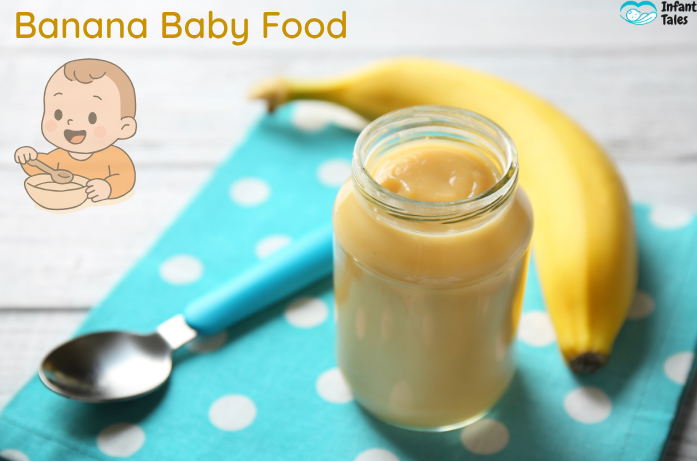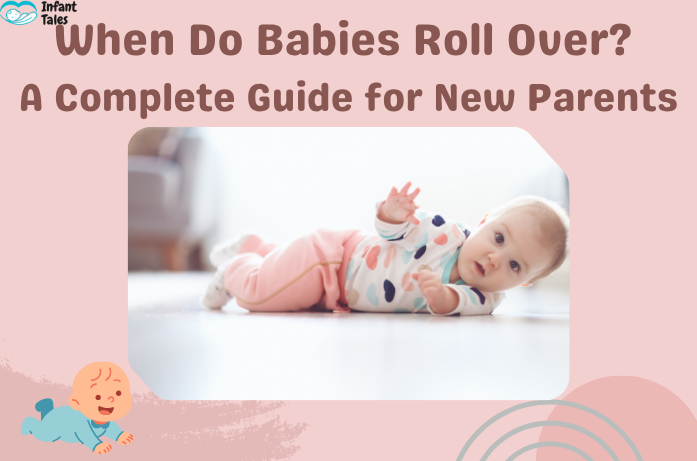By a Caring Mom at Infant Tales
Introducing solid foods to your baby is one of the most joyful and fulfilling moments of parenthood. It’s a mix of excitement, curiosity, and a little apprehension. What would be the best first food for them? Among the many options, banana baby food is often recommended by doctors and is a favorite among parents around the world. This is because it’s gentle on your baby’s stomach, packed with nutrients and its naturally sweet taste makes it one of the easiest first foods for babies.
The vitamins and minerals found in bananas contribute to a baby’s early development. Furthermore, banana puree for babies is very easy to make, requires no cooking, and can be given fresh at any time. Whether you’re starting to make banana puree for your baby at six months of age or experimenting with new flavors as your baby grows, this article will provide you with step-by-step guidance on all aspects of its benefits, preparation, and safe feeding tips.
When Can You Start Giving Banana to Your Baby?
Typically, babies begin chewing banana puree around 6 months of age, as soon as their behavior indicates they’re ready for solid foods. The American Academy of Pediatrics (AAP) suggests that the ideal time to introduce solid foods is when a baby can sit with some support, show interest in food, and can swallow semi-solids. This is when it’s appropriate to introduce smooth and easily digestible foods like banana puree.
Bananas are a great choice because they are soft, mild, and naturally mashable, no need for fancy equipment or cooking. They are also low on allergen risk, making them an ideal baby first food banana option. For the first few days, offer a small amount (1-2 teaspoons) of the puree and gradually increase the quantity as your baby becomes familiar with the taste and texture.
Nutritional and Health Benefits of Bananas for Babies
A banana can be an unpretentious fruit, but it is loaded with nutrients that are very beneficial for your baby. Every spoonful of banana baby food gives your baby essential nutrients such as:
- Potassium, which supports heart and muscle health.
- Vitamin C, which helps boost immunity.
- Vitamin B6, crucial for brain development.
- Dietary fiber, which supports digestion.
The natural sweetness of bananas makes them a top choice for baby food starters that make the transition from milk to solids easier for your little one. The easy-to-swallow, creamy texture of banana puree for babies is also gentle on the stomach, reducing the chances of constipation or indigestion if administered correctly.
Bananas also provide long-lasting energy, which helps growing babies stay active and playful throughout the day. That’s why many parents prefer banana puree as a go-to breakfast or mid-day snack for their little ones.
How to Choose the Best Banana for Baby Food
Not all bananas are created equal when it comes to baby food. For banana puree for baby, choose ripe bananas with yellow skin and a few small brown spots. These bananas are naturally sweet and soft, making them easier to mash into a smooth puree.
Avoid unripe (green) or overly mushy black bananas, as they may be too difficult to digest or have lost their freshness. If available, organic bananas are the best choice as they are cultivated without the use of pesticides. However, if you are using regular bananas, wash and peel them thoroughly before making banana puree for babies.
When introducing solids for the first time, always use fresh bananas and avoid storing cut fruit for too long, as it can lose nutrients and change in color due to oxidation.
Step-by-Step Recipe: How to Make Banana Baby Food
Making banana baby food at home is quick, economical, and incredibly easy. Here’s a recipe that takes less than five minutes!
Ingredients:
- 1 ripe banana
- 1-2 tablespoons of breast milk, formula, or boiled & cooled water (optional)
Method:
- Peel the banana and cut it into small pieces.
- Using a fork or blender, mash or blend the banana until it becomes a smooth puree.
- Add a little liquid (breast milk, formula, or water) to reach your desired consistency, especially for younger babies around 6 months.
- Serve immediately in a clean baby bowl.
Texture Tips:
- For babies aged 6–7 months: Make a smooth banana puree with a creamy texture.
- For babies aged 8–10 months: Mash the banana coarsely to introduce texture and help with chewing development.
Storage: In an airtight container, banana puree for the baby can be kept in the refrigerator for a maximum of 24 hours. For longer duration, keep it frozen in small amounts using ice cube trays and one cube at a time when needed.
This simple process is the best example of preparing banana baby food that is fresh and full of nutrients, with no preservatives, no sugar, only love!

Banana Baby Food Combinations as Baby Grows
As your little one matures and gets used to taking purees with single ingredients, you can mix bananas with other baby-friendly foods to make mealtimes more fun and healthy food. Some of the wonderful combinations for baby banana puree include:
- Banana + Apple Puree: A gentle, naturally sweet mix full of fiber and vitamins.
- Banana + Avocado Mash: Smooth and loaded with healthy fats, which are good for brain growth.
- Banana + Oatmeal: The perfect breakfast with increased iron and fiber.
- Banana + Yogurt: For babies over 8 months, rich in probiotics for digestive health.
It’s important to remember that your baby should only be given one food at a time, and only introduce new foods after 2-3 days. This is to detect any allergic reactions early.
Safety Tips and Precautions
- Always introduce banana baby food as a single-ingredient puree at first.
- No need for sugar, honey, or salt; just give the babies a plain diet.
- Watch your baby for any signs of allergy (though it is very rare that a baby will be allergic to bananas).
- Practice good hygiene: wash hands, pots, and feeding bowls before preparation.
- Serve banana puree fresh whenever possible because bananas turn brown quickly.
Following these precautions ensures your banana puree for baby is safe, nutritious, and enjoyable.
Helpful Feeding Tips for New Parents
Feeding the infant is not only providing the baby with food it is also a way of bonding. Here are some delicate tips:
- Start with a very small amount and look at the baby’s reactions.
- The baby should be in an upright position while eating to prevent choking.
- Do not force-feed; allow your baby to set up the speed.
- Increase the hardness of the food gradually as the baby gets older, starting with smooth banana puree and moving on to soft chunks.
The feeding process of each baby is different. Some will fall in love with bananas right away while others will need a few more times, patience, and consistency will be the key though.
Final Thoughts: Feeding Your Baby Naturally
Bananas are an easy, natural, and pure first food. Making banana puree for babies at home not only preserves freshness but also lets parents know exactly what’s in their baby’s food. With its delicious taste, easy preparation, and excellent nutritional value, banana puree for babies is a great addition to every baby’s weaning plan.
Feeding your baby doesn’t have to be a difficult task. A ripe banana can be a food full of love, health, and growth. So the next time you think about making banana baby food, just grab a banana and you’re ready to make magic happen in just minutes!
Common Questions Parents Ask About Banana Puree
1. Can I give banana every day to my baby?
you can give banana puree in small portions daily. It is nutritious and versatile but should be taken along with other fruits and vegetables in a proper manner.
2. Does banana cause constipation?
Most ripe bananas don’t cause constipation. Their fiber content improves digestion. Unripe bananas, on the other hand, are less digestible, so it’s always best to use ripe bananas when making banana puree for babies.
3. How long can I store banana baby food?
Fresh banana puree is always the best option but if necessary it can be refrigerated for 24 hours or frozen for up to a month.
4. Can I mix banana puree with other foods?
Certainly! Banana puree for babies goes very well with apples, pears, avocados, or even cereals and yogurt.
Follow Infant Tales for more baby food recipes, parenting insights, and nurturing guides to help you through every milestone of your baby’s beautiful journey.
Disclaimer: This article is for informational purposes only and should not replace medical advice. Always consult your pediatrician before introducing new foods, especially if your baby has allergies or digestive issues.



